Introduction
If you’re interested in learning more about warehouse management systems (WMS) and all the business-critical processes related to them, you’ve come to the right place.
In this article, we will cover vital WMS aspects, such as:
- What is a warehouse management system?
- What types of warehouse management systems and warehouse management software can you buy?
- Which type of system is a WMS usually connected to?
- What are the benefits of a WMS?
- Four quick & easy wareho use layout tips for effective barcode implementation
- The WMS process & best practices for each stage
- A comparison of standalone and integrated WMS
- The potential benefits of hosting your WMS in the cloud
- Hints and tips for the utmost efficiency in your warehouse
But if you’re after different information about warehouse management systems, we also have you covered. Just take a look through the blogs, guides, and customer stories we have on WMS.
What is a warehouse management system?
A warehouse management system (WMS) is software that is designed and built to optimize the warehouse, distribution, supply chain, and fulfillment processes within a business.
Typically, a WMS will provide functionality to help streamline and improve these warehouse processes, right from when goods first enter the warehouse, through the putaway process, and all the way until they leave (and if they are returned!)
Warehouse management systems can also be connected and integrated with other types of software so that the processes across the business are all interconnected, smooth, and streamlined. Something which chimes ideally with today’s age of omnichannel retail, which is necessary to meet customer demand.
But not all warehouse management systems or WMS software solutions are built equal.

Types of warehouse management systems


Standalone WMS vs Integrated WMS
Now you know the fundamentals of warehouse management systems, the time’s right to start thinking about the type of system that will suit your business.
There are two main options for warehouse management software.
You can either choose a standalone product and integrate it with the rest of your back office and operational systems, or choose an integrated solution where the WMS shares the same database and workflows as your order management, inventory, and accounting.
Below, you’ll find the pros and cons of each option so you can decide what’s best for your business.
Standalone WMS
Standalone WMS is sold as specialized warehouse management software. Although it can be integrated with other systems like inventory control software, order management software, and purchase ordering software, the focus here is on warehouse management features above all other functionality.
Pros
- Advanced warehouse management features: From a wide array of warehouse picking options and cycle counting, to cross-docking and advanced reporting features, standalone WMS often provides world-class warehouse management features and advanced functionality.
- Integration capabilities: Despite the lack of other operational features, standalone WMS can often be integrated with other systems you use. Including accounting software, order and inventory management software, purchase ordering systems, point of sale, and Enterprise Resource Planning (ERP) solutions. As well as other related tools like supply chain management (SCM) software and transportation management systems (TMS).
Cons
- Siloed systems: Your staff across the board will need to log into separate systems in order to complete all of your functions. For instance, when goods come into your warehouse on the back of a customer return, your team will first need to update your warehousing software, followed by your CRM and accounting software. That’s far too many clicks for one customer return!
- Lack of real-time integration: Your warehouse team will be isolated from the rest of your company as they will only have access to a separate system, which may not have the integrations or capability in place to be updated in real time. You run the risk of them being minutes, hours or even a day behind your other systems.
- Not retail centric: Although you may have purchased the best WMS system available, it’s unlikely to be retail centric. Many standalone warehouse systems cater to a number of business types, from retail and wholesale, to manufacturing and distribution. This affects the support and business advice you’ll have access to, as well as increasing the risk of you paying for features you simply don’t need.
- Increased costs: By needing to purchase, implement, and maintain multiple systems in order to get all of the core functionality your business needs, your costs will quickly add up. You’ll need to assess just how much ROI the standalone WMS will offer and offset that against the increased technology spend.
Integrated WMS
As the name implies, integrated WMS is a solution that is either included in your existing ERP or back office software, or is an additional module that is usually sold by your back office or ERP vendor. This means the WMS shares the same database as all your orders, inventory, accounting, CRM and reporting.
Pros
- Centralized data: With your warehouse data using the same database as your orders, e-commerce integrations and accounting, your staff will not only have the same knowledge as each other, but you’ll also gain real-time accuracy and consistency across your data as well.
- Consistent customer experience: Regardless of who your customers speak to, if they’re all singing from the same hymn sheet, then your customers will receive a consistent (and improved) customer experience.
- Simplified workflows: Integrated WMS has been designed and built with back office and ERP software in mind, which means you’ll benefit from simplified and seamless workflows throughout the order-to-cash cycle.
- Lower cost: Your overall technology spend will likely be lower compared with purchasing and implementing multiple systems.
Cons
- Reduced functionality: Although an ERP WMS module will offer the main functionality you need in the warehouse, it may lack some of the more complex and advanced functionality of a standalone warehouse management solution.
When considering buying any new software, especially warehouse management systems, remember to look into pricing arrangements all the types of cost that may occur, including (but not limited to):
- Infrastructure
- Hardware
- Software
- Licensing fees
- Implementation
- Maintenance
- Customization & optimization
- IT labor costs
- Other labor management costs
WMS vendors selling cloud-based, SaaS, and integrable WMS solutions will often handle a lot of these costs themselves, and thus, your main responsibility will be for software, licensing, and one-off implementation costs.
What are the benefits of a WMS?
There are many benefits that a WMS implementation will bring to your business, from providing you with the ability to make data-driven decisions quickly and easily, to reducing your order fulfillment latency and processing costs.
Let’s take a deep-dive into the top five WMS benefits:
1. More informed data-driven decisions
As the most powerful warehouse management systems will be connected to your inventory availability and sales channels, they should operate in real-time.
This means you can quickly identify issues with high risk or high value items, such as in the event of warehouse theft or when goods are routinely damaged in-transit are a couple of examples.
You can also report on the productivity of your warehouse team faster than without a WMS, ensuring you know what their time is spent the most on, and thus, which parts of the process need to be improved as a priority.
2. Faster order fulfillment
In the current highly competitive retail environment and with same and next-day delivery becoming the norm, you’ll need to find tools and process improvements to help reduce this time. This is where an efficient warehouse management system comes in.
With a WMS working alongside barcode scanners, your warehouse team will be much faster at picking and packing orders, and thus, your order fulfillment latency and processing times will be reduced.
3. Reduced processing costs
If it takes less time to pick and pack orders, and to complete other warehouse processes such as the receiving of deliveries, it’s inevitable that your processing costs are also going to be drastically reduced.
It makes sense to calculate your current processing cost per order now, and then you can see just how much return on investment you receive when implementing a WMS.

4. Error elimination
Barcoded inventory and a warehouse management system are both designed to reduce the time spent on admin, which in turn, greatly reduces the risk of error.
With a WMS in place, your warehouse staff can simply scan product barcodes when picking, packing and shipping orders, as well as when goods are incoming. When doing so, the WMS will alert them if the wrong product has been scanned, and will automatically communicate inventory changes across your sales channels in real-time.
Not only will this eliminate errors, but you’ll also reduce the risk of frustrated customers and bad reviews.
5. Time-saving
We’ve already touched on how a WMS can reduce the time spent on admin, packing orders and receiving deliveries, but what about the all-important stock take?
Barcode scanners will continue to save you time when performing stock takes, but there is also the opportunity to improve things even further with cycle counts. We discuss what a cycle count is and the best cycle count procedures to use in this inventory management article.
And for even more WMS benefits, read this guest blog from Explore WMS.
Four quick & easy warehouse layout tips for effective barcode implementation
Implementing a barcode system in the warehouse requires more effort than just sticking labels onto your products and using barcode scanners. Your warehouse should be laid out in a way that optimizes your processes and increases your efficiency even further.
For some quick tips, consider the following:
-
Group similar items together in the warehouse
-
Place best selling items near the packing station
-
Designate specific areas for peak season products, on sale items and best sellers
-
Barcodes should face outwards from shelves and upwards within bins
Grouping similar items together within the warehouse is known as “slotting”. You could stack items that are regularly sold together near to each other in the warehouse, or maybe you have a great promotion on to offer a free mug with every tshirt purchase – update your warehouse to reflect these promotions, even if they’re only temporary. Your warehouse staff will certainly thank you for it, as will your customers when they receive their goods quicker!
Other warehouse layout ideas include placing best selling products near to the packing station, and designating specific areas in the warehouse that hold peak season products and on sale items, alongside those best sellers.
You can also make it even easier for your staff to scan barcodes, by ensuring that your freshly organized warehouse requires barcodes to be facing outwards on the shelf, or upwards within the bin.
If your warehouse layout behaves in a way that makes it quick and easy for warehouse staff to locate items and locations, then your newly implemented barcode system is set to be a winner.
The Warehouse Management Process
Now we’ve covered the basics of warehouse management systems, let’s get into the nitty-gritty. Your warehouse management process incorporates all of the steps your staff need to take in order to get your products from your warehouse to your customers – quickly and efficiently.
The steps involved include order picking, packing, shipping, and receiving inventory.
Let’s take a look at each of these steps in more detail, whilst highlighting warehouse management best practices you should adopt to improve your warehouse efficiency even further at each stage.

Picking
Warehouse picking, or order picking, is the concept of collecting all items for a selection of orders and taking them back to a packing station to be distributed into their individual packages.
The headline rationale for adopting warehouse picking is to cut down on the time spent walking around, instantly making things more efficient.
It’s surprising how many established retailers we come across that aren’t yet picking. We see it as a key warehouse fundamental you can adopt within your order assembly and dispatch workflows relatively easily, while seeing the benefits instantly.
Warehouse picking differs throughout industries, but there is common terminology you need to know about:
- Picking is the act of gathering goods from around the warehouse (on shelves and pallets or in bins) or inventory stores.
- A Picker is the job role or title given to the person doing the picking.
- A Picking list is the list of all items that are to be gathered.
- A Picking batch is the list of orders that will be fulfilled via the picking list.
Prioritizing your picking list
It differs from business to business, but listed below are the most common methods of prioritizing your picking list:
- Prioritize by shipping method.
Either by service level, or carrier pickup times in a world of free shipping. Delivery SLAs are bespoke to the company, but next-day or other premium services should take precedence over others.
- Prioritize single item orders.
Very common with our marketplace sellers, this has been cited multiple times as the quickest way to reduce the overall to do list. The benefits aren’t necessarily immediately felt by the picker, but the time will be saved when packing the items (as the person taking the items to the packing station innately knows the items shouldn’t be grouped together).
Warehouse picking procedures
Your picking method will depend on both your business and how your warehouse operates, but to help, we’ve listed the most common types of warehouse picking procedures below:
Discrete: Working from a master list, your employees will pick one order each, one line at a time. When finished, they’ll move onto the next order, again, picking items one line at a time.
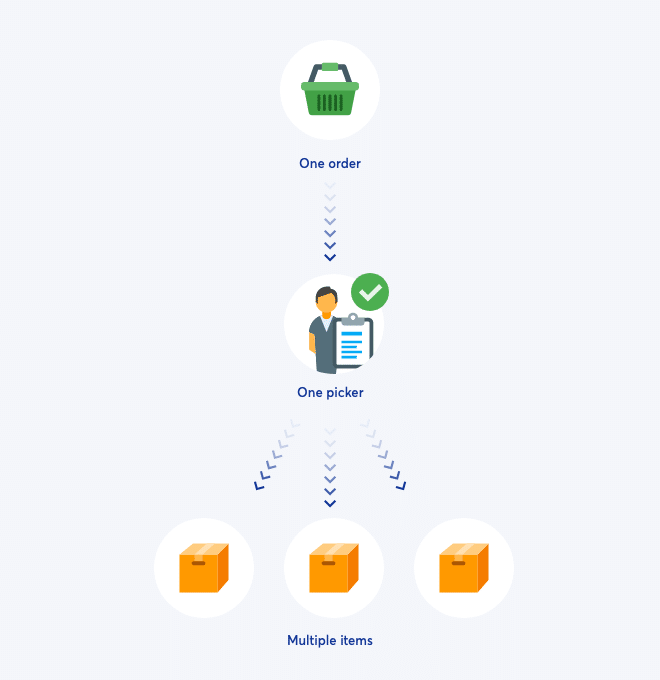
Wave: Similarly to discrete order picking, your team will each pick one order, one line at a time. However, with wave picking, you’ll also set a scheduling window for orders to be picked at specific times of the day.
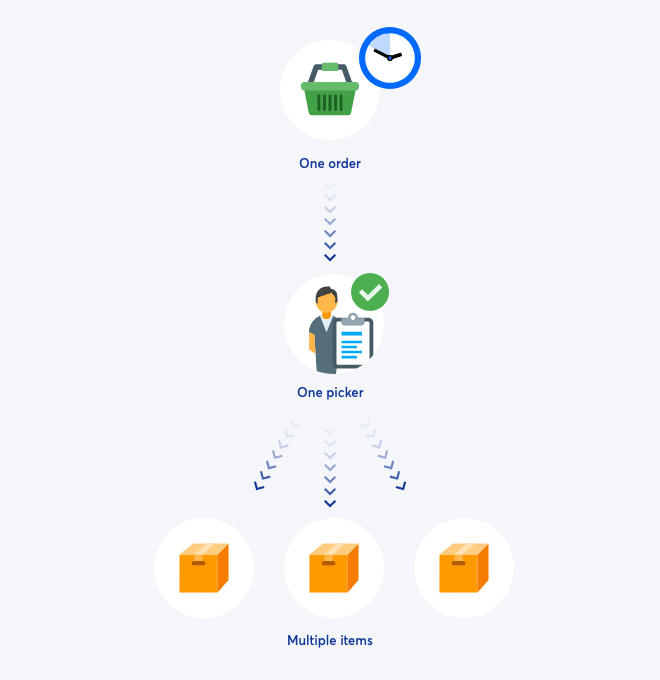
Cluster: Your team will pick multiple items in one go that fulfill a group of orders. When finished, they’ll move onto the next group of items that fulfill another group of orders.
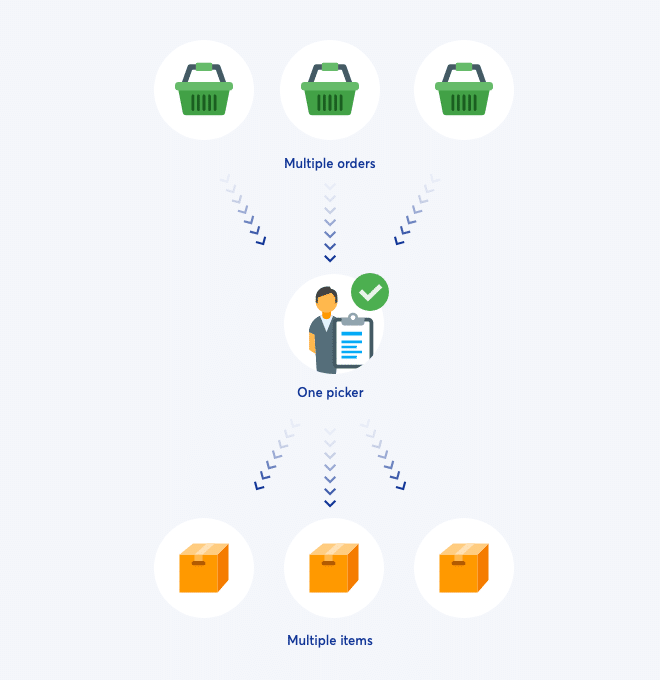
Zone: In this setup, your pickers are each assigned their own specific zone in the warehouse to pick from. When finished, they’ll wait for more orders to come in for items within their dedicated zones.
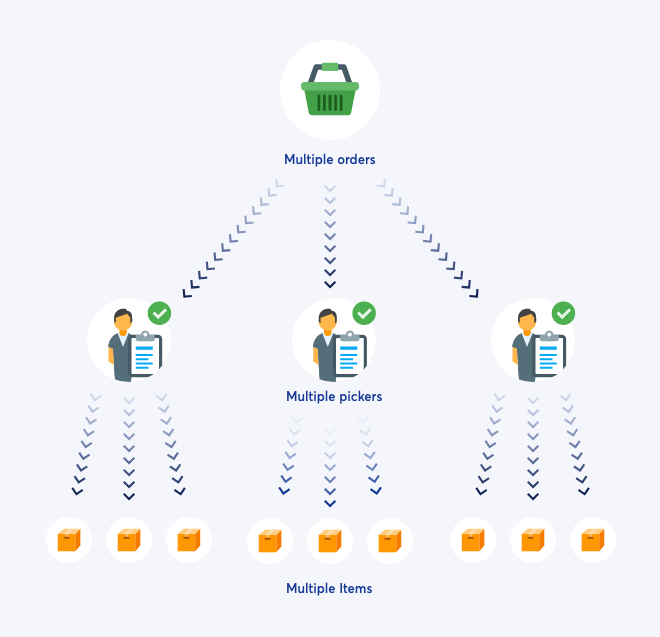
Batch: Working from a master list, your team will each pick items for a small group of orders regardless of product location.
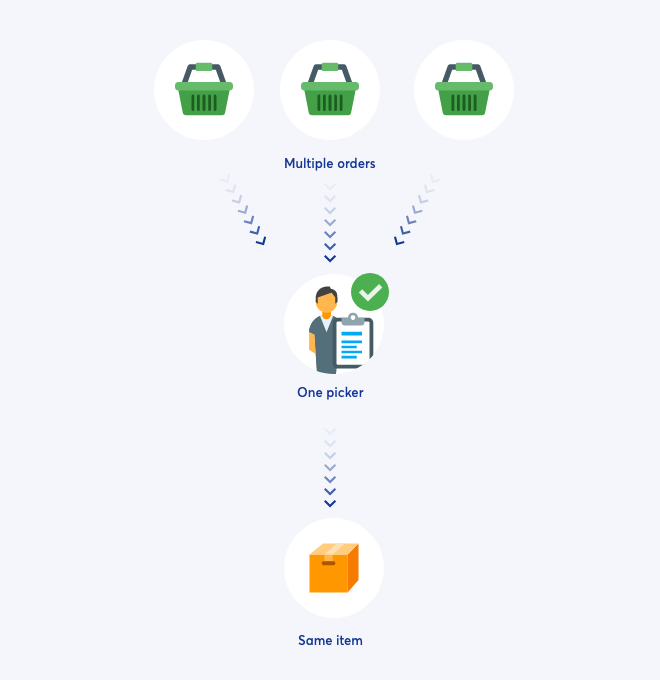
You can also combine picking methods for increased efficiency such as zone-wave, zone-batch or even zone-wave-batch picking.
Packing
Packing, as explained in the name, is the process of physically packaging the items up ready for outbound shipment.
It’s sometimes the forgotten middle child within the warehouse management process, but packing is no less important.
This stage of the process is an opportunity to ensure you’re sending the right products to the right customers in the most efficient way… and in accordance with your business’ vision and values.
Top tips for speeding up your packing process
Help reduce your processing cost per order by implementing these simple tips to speed up your packing process:
- Organize your packing station. Ensure your staff have access to all the packing materials they’ll need but keep the stations free from unnecessary clutter.
- Review your existing packaging. Instead of standard boxes that need assembling and taping, consider self-sealing, crash lock boxes and/or wrap packs, both of which considerably increase your team’s packing speed.
- Consider packaging automation. There are a myriad of automated machine systems that exist solely to speed up the packing process, such as Sealed Air’s e-Cube®, FloWrap™ or StealthWrap™.
- Automate your packing label creation. While your workers are busy picking and packing shipments, intelligent systems integrations, such as Shiptheory and ShipStation can be implemented to automatically create packing labels and tracking references.
Personalized packaging as a competitive advantage

Where previously, products were delivered in boring boxes that did nothing to grab the customer’s attention, businesses today are rapidly seeing the benefits of using branded or personalized packaging to increase their brand engagement, word-of-mouth sales and presence across visual social media platforms like Instagram.
Here are a few simple tweaks you can make to your warehouse packing procedures to harness the power of personalization:
- Handwritten Notes: One of the simplest ways to instill positive emotions when opening your packages is with a handwritten note thanking your customer for their purchase and detailing how they can contact you or share their experience on social.
- Coupons and Discounts: The right coupons and discounts have the power to not only increase your revenue but make customers feel incredibly valued. You could even try creating five to ten different offers and randomizing them across your orders. That way, your customers will be more likely to get something unique each time and shout even louder on social.
- Custom Hashtags: To promote even more social shares and word of mouth sales, don’t forget to include custom social media hashtags on your packaging or on notes inside your packaging.
- Free Gifts: Your customers will be far more motivated to buy from you again if they open their packages to find a little gift or two alongside the product they ordered. They’ll also be more likely to share their experience on social or leave a positive review.
Shipping
As mission-critical as an efficient picking and packing process is, physically delivering your items in a proactive, premium, yet cost-effective manner will help you build best-in-class customer loyalty, differentiate from your competition and increase customer lifetime value.
With this in mind, consider the following warehouse shipping best practices:
- Provide estimated delivery dates and tracking updates
Throughout the checkout process, you should endeavor to provide your customers with estimated delivery dates. Once the items have been physically shipped, setup some automatic triggers in your order management software to send tracking information and dispatch notifications via email and/or SMS to your customers. - Utilize multiple carrier options
Today’s online consumers expect flexibility when it comes to delivery options. Depending on the level of urgency, product dimensions, product category and final destination, you should utilize a wide range of shipping services from multiple providers. While some carriers’ core competency lies within domestic shipments, others are better suited to cross-border trading, while adverse weather, strikes and technical outages can affect some carriers significantly more than others. By utilizing a broad range of carrier options and services, you can safeguard yourself from being left without a service. - Implement automated shipping integrations
By using shipping integrations like ShipStation and Shiptheory with your order management or retail ERP software applications, you can automate the creation of shipping labels and tracking references, while ensuring these systems are selecting the appropriate shipping method and postage cost for you, based on things like package weight, item type, order value and destination address.
Receiving inventory
Receiving procedures in a warehouse are spread across new products coming in from your suppliers for replenishment, as well as customer returns and exchanges.
Your receiving procedures should be as slick and efficient as your pick, pack, ship processes. Consider the following:
- Should your warehouse workers put away now or later?
- Do you need a quarantined location for returned inventory so that items can be assessed at a later time? If so, where is it and how is it used?
- Do you use a hassle-free returns process? In other words, do you offer a returns label in your packages? Or do customers need to request returns?
- Will any 3PL warehouse you use be able to receive returned goods?
- Do you offer store credits and exchanges to your customers as well as returns?
- Do your customers need to use the original packaging or their own?
- Should the original packing note be included in returned packages?
- Should products be returned within a particular time frame? If so, how long will your customers have after delivery?
- Have you accounted for inbound goods when planning your yard management?
- Who is responsible for the costs of sending the item back?
- Does your inventory tracking benefit from real-time visibility when goods are delivered to your warehouses?
Using technology to streamline your pick, pack, ship process
Warehouses can benefit immensely from the right technology, perhaps even more so than any other department within a retail business. It will significantly cut down on errors, save time, and grant the rest of the business insight into what’s going on. All of which can help give you a competitive edge.
Warehouse management software can prepare picking lists ready to simply be printed out from an intuitive user interface and executed by a picker. The solution in place should ideally be able to print all required labels or paperwork (e.g. picking lists and packing notes) in one go for a given batch.
Secondly, any good order or warehouse management system will have ample flexibility for generating picking batches. Whether prioritizing by the number of items contained in the order, or by sales channel, shipping method or any other means, you need the ability to fulfill your desired orders.
As a final point, software that enables you to go digital by putting a barcode scanner in the hands of your pickers, or turn any mobile device into one, will neutralize all incorrect picks. A barcode-driven pick will literally only allow pickers to gather the exact items needed. This is particularly true for those with near-identical inventory, which will naturally slow pickers down if they have to match up the barcodes or SKUs manually at each stop.
6 Key Benefits of Cloud WMS
As well as choosing between standalone and integrated WMS, business also have another crucial decision. That is between implementing on-premises or cloud-based WMS.
Today, we’re seeing more and more merchants adopting cloud technology and implementing what some have deemed, a paperless warehouse.
Just look at the current stats:
Cloud computing spending has been growing at 4.5 times the rate of IT spending since 2009. [Source: Forbes]
6.5% of WMS users are currently in the cloud. That number will jump to 35.4% by 2020. [Source: Supply Chain Digest]
60 – 70% of all software, services and technology spending will be cloud-based by 2020. [Source: Forbes]
With this in mind, listed below are six key benefits you’ll gain access to when adopting a cloud WMS solution.
1. Cloud-Based Connectivity

Cloud-based systems by their very nature have been designed to work in unison with other systems.
Why should your warehouse be any different?
By ensuring you’re working in the cloud, your sales channels, inventory reports, and financials will be updated with every shipment, incoming delivery, manual inventory adjustment, or warehouse transfer. Not to mention having greater ease connecting with external systems, like those of your suppliers or distributors.
2. Data-Driven Decisions
Cloud-based connectivity, combined with real-time updates mean you can make informed, data-driven business decisions at any time.
Quickly identify issues with high risk or high value goods, report on the productivity of your warehouse team and what their time is spent most on.
Use all of this data to make improvements where needed and focus on revenue growth.
3. Cost Effective
Reduced infrastructure, hardware, software and licensing costs mean that cloud-based systems offer a lower total cost of ownership and eliminate the need for large capital outlays compared with on premise solutions.
These costs can then be reallocated towards the growth and scalability of your business, moving your focus from your operations behind the scenes to the front of house.
4. Slick & Speedy
As configuration, hosting, setup and implementation are all managed by the vendor selling the cloud WMS, these systems take mere weeks to setup, rather than months or even years for a traditional on premise solution.
In fact, at Brightpearl, we get businesses launched with our complete retail operations platform in a third of the time of traditional ERP systems on average.
5. Continuous Improvement
Cloud WMS users receive regular and routine updates as part of a continuous improvement model, and can avoid the dreaded experience on premise solutions bring with their large version upgrades.
This ensures you always benefit from the latest features, with no need to work with developers to help you update your system.
6. Business Integrations
With your warehouse operating from a cloud-based solution, you can ensure your entire business is integrated with your WMS.
For example, think about inventory updates, which should update both your accounting and warehouse records.
How these types of processes all integrate with one another will greatly influence just how powerful your WMS can be.
Cloud vs Legacy WMS Infographic
Warehouse Management Best Practices
What we’ve covered so far have largely been the nuts and bolts of warehouse management and WMS. What you need to remember throughout, though, is that your aim every step of the way is to keep your customers happy. To do that you need every element of your warehouse management to be swift, efficient, and optimized.
To satisfy your customers’ demands for speed and flexibility when it comes to their orders and returns, you’ll need to adopt warehouse management best practices and specialist technology within your business.
Listed below are our top tips for gaining efficiency in the warehouse, alongside advice on how you can correctly adopt and implement multi-location warehouse management.
How to Gain Efficiency in the Warehouse
1. Automate time-consuming warehouse processes
In aid of reducing order processing time and costs, consider the use of automation bots throughout your dispatch process.
Consider this order fulfillment workflow:
- An order downloads from your online sales channel into your central retail management system.
- This order is instantly allocated and fulfilled due to enough inventory being available.
- The order status is automatically changed to “Ready for dispatch”, based on a clear set of rules for things like payment, allocation and fulfillment status.
- The order is automatically sent to your warehouse team.
- Your warehouse team pick, pack and ship the order.
Notice how in this workflow, a middle person who would have been initially checking the order, whilst manually marking it as allocated, fulfilled and ready for dispatch is no longer needed.
By using automation bots to speed up your order processing, your warehouse team can get on with what they do best – picking, packing and shipping orders quickly, to increase customer satisfaction and ultimately, drive more sales.
2. Use barcodes and barcode scanners

Gone are the days when you had to either use pen and paper in the warehouse or use corded devices.
By using bluetooth barcode scanners in your picking and packing processes, you reduce the possibility of human error from mistyping numbers.
Which means that using this type of technology alone could drastically improve your perfect order rate, whilst reducing your costs and processing times.
3. Implement EDI integrations

Electronic Data Interchange (EDI) is the computer-to-computer exchange of documents in a standard electronic format between business partners.
It’s becoming increasingly popular with businesses of all sizes, but especially those who wish to work with large suppliers like Tesco, Walmart and Target.
By implementing EDI, you can:
- Prevent double selling.
- Reduce the amount of incorrect shipping documents being created.
- Prevent mispicks and incorrect items from being sent out.
- Reduce the number of missed delivery deadlines.
- Track, monitor and chase supplier delays.
- Send tracking information to customers automatically.
4. Use an integrated warehouse inventory system
43% of businesses surveyed in the US are still using pen and paper in the warehouse.
Consider the amount of hours that warehouse workers are spending on checking inventory, writing figures down and then updating systems manually afterwards.
Instead, by using an integrated warehouse management system, your team will be able to easily scan goods in and out of the warehouse, update inventory levels, prioritize picking lists, use batch, wave, zone or discrete order picking, and perform inventory counts quickly using a barcode scanner.
5. Frequently analyze your warehouse efficiency
With larger warehouses, more sales, and faster turnaround times demanded by customers, keeping your warehouse running smoothly should be one of your top business priorities.
Running the right reports is a critical piece to assessing your warehouse’s stocking, pulling, and inventory management processes.
We recommend you analyze the following reports and metrics regularly, and act on your findings:
- Variance reports
- Processing cost per order KPI
- Time to ship KPI
- Reasons for return
- Supplier reports and history by supplier
- Empty bin report
- Expense controls
Multi-Location Warehouse Management Best Practices

In addition to the above, you’ll also need to adopt best practice when operating out of multiple warehouses and store locations, whether you manage them yourselves or some are run by third-party logistics (3PL) providers.
Listed below are our top tips for developing a successful multi-location warehouse strategy.
1. Maintain separate product counts per warehouse
When operating out of multiple warehouses and store locations, it’s vital that you know how much of each product is stocked in each warehouse.
Therefore, any warehouse or inventory management systems you use should be able to display overall inventory levels for each product alongside more granular detail on what is stored where.
Having this data to hand ensures that you won’t run low, or run out of stock in one location, while overstocking in another.
2. Devise individual strategies on where to send products
A multi-location warehouse operation and a good warehouse strategy means you can keep products where it’s most convenient to, as opposed to simply wherever you have space.
If you’re unsure where to start regarding devising a solid multi-location warehouse strategy, consider the following ideas:
- Automate your warehouse routing based on region. If your business is particularly prevalent within a region, whether domestic or international, consider the benefits you’ll gain by setting up warehouse premises in that region and storing frequently purchased products there.
- Store slow moving inventory together. Not only can you store slow moving inventory in locations next to each other within one warehouse, but you could also consider using a specific warehouse for that slow moving inventory as well – perhaps one with cheaper storage or operating costs.
- Stock popular products across all your warehouses. If you know some of your products are particularly popular, consider storing inventory for these items across all your warehouses. This ensures orders for these items can be just as fast moving as the stock, rather than running the risk of having to reorder items or transfer inventory between warehouses.
3. Decide whether to use standard warehouse management or multiple concurrent warehousing
You should decide whether standard warehouse management or multiple concurrent warehousing is best for your business.
Standard warehouse management indicates that each of your product lines have a set location they should always be stored in. For example, your Hugo Boss t-shirts are only stored within Zone D in your Austin, Texas warehouse.
Whereas multiple concurrent warehousing means either some or all of your items will be stored within multiple locations across one warehouse or even all your warehouses. For example, your Hugo Boss t-shirts are usually only stored within Zone D in your Austin, Texas warehouse, however at peak trading times, they’re also kept in Zone A as it’s closer to your packing station and it’s a popular gift item.
Whichever warehouse operations model you choose, make sure your technology is flexible enough to handle both situations.
4. Divide inventory risk across warehouses
By operating out of multiple warehouses, you should take full advantage of being able to divide your inventory risk across premises.
Whether you divide your most popular or valuable items across warehouses, this will ensure you help mitigate risks if something untoward were to happen such as lost inventory, theft or warehouse fires.
5. Use inventory forecasting best practices
Managing inventory in one location is challenging enough as it is, but throw in multiple warehouses – each with their own inner-warehouse locations into the mix – and you add a whole new layer of complexity.
Be sure to adopt inventory forecasting best practices within your business to mitigate the risks of overstocking, or worse, overselling from certain warehouses.
6. Get to grips with warehouse transfers
Even if you have a solid process for keeping all your warehouses fully stocked, you may occasionally need to transfer goods between your warehouses.
Ensure you have a documented process in place for employees to follow for both sending inventory out from the starting warehouse, receiving it in at the other end, and placing the items back into rotation.

